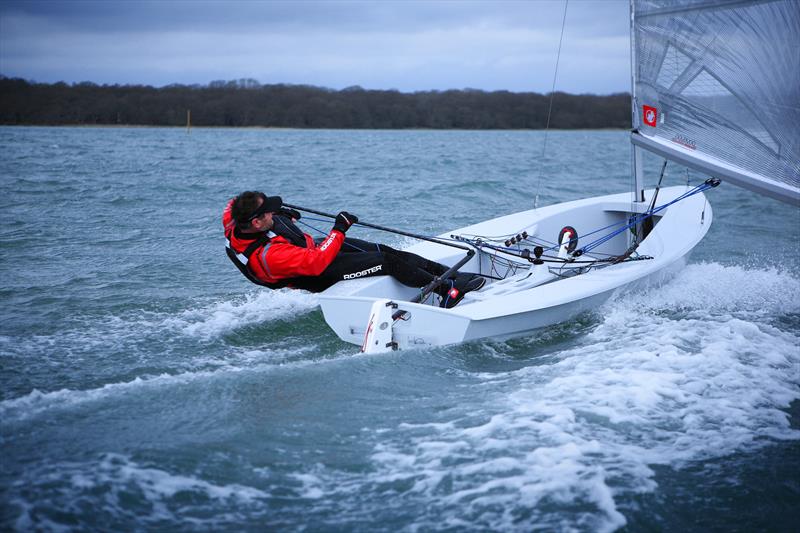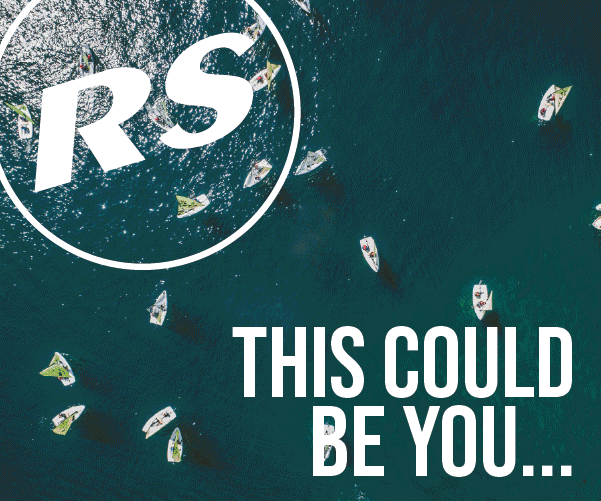
Technique : Hiking Styles - by Steve Cockerill
by Steve Cockerill 18 Mar 2000 08:31 GMT

Steve Cockerill sailing his Solo © Dave Treagust
-202405030836.gif)

Steve Cockerill discuses some of the typical problems associated with hiking out and takes advice from Fiona Taylor, a physiotherapist who has often been found in dark corners of Sailing Clubs at Laser 4000 regattas, with strange men and women complaining of aches and pains. The main area of concern for us is our knee; bad knee pain affects most of us throughout our sailing careers and can often be the reason for changing to more pedestrian classes sooner than we would like. In the majority of cases the source of knee pain is from behind/under the kneecap (patella). This joint is particularly vulnerable in sailors because of the loads placed on the joint in the hiking position and the joint shape that relies on specific muscle activity. I have seen many young sailors using bad and ineffective hiking styles that will, if not corrected, store up problems for them in later life. I am afraid it is a subject that if we do not take seriously can lead to bar talk like ‘I could not carry on sailing a single-hander, ‘cause my knees gave out’. Having had an aggravating knee problem myself, I have been keen to write this article for some time to ensure that we all develop good, healthy and effective hiking styles and enjoy this physical aspect of our sport for many years to come. Fortunately for me, I have changed my techniques, which have in turn helped repair my knee, and as a bonus improved my speed. I was diagnosed with chrondromalica patella some 10 years ago. This condition is common amongst all types of athletes. It basically means that I had an imbalance in the muscle groups around the knee that in my case was caused by a bad hiking style. This bad style caused the muscles to develop in an unbalanced way which caused the knee cap to move out of track and become inflamed and very painful. When I got tired I had a natural leaning forward style which involved rotating my aft foot forward and using the stronger and more stamina resistant outer quadriceps to maintain the hiking position. Obviously when we exercise we are going to develop our muscles, but bad exercises can allow the outer quad to quickly become the dominant muscle and allow it to pull the kneecap to the lateral or outer side. The critical aspect of the muscles around the knee cap is their balance around the joint. The key muscle in the balance and stability of the knee and yet the hardest to develop and maintain is the inner quadriceps. This muscle requires much harder work to develop and maintain but it ensures the balance between the large small angled pull of the outer quadriceps and the small large angled pull of the inner quadriceps.  In serious cases the only cause of action is to purposefully damage the lateral muscle (lateral release) in order for the other muscles to regain the upper hand in the control of the kneecap. The other alternatives are to take rest and anti-inflammatory drugs, which make the pain go away but leaves the knee prone to further damage, or exercise in specific ways to encourage the inner quad to develop and re introduce the balance around the knee cap. Thankfully my case was not too bad, so specific exercises was the key. I spent 6 months with a piece of elastic looped over the end of my foot and around a table leg. I had to pull my right foot against the elastic toward my left foot, with a twisting motion. It caused a few strange looks from my work mates but this re-educated my inner quadriceps to take control! When sailing, I had to concentrate to keep my feet pointing outwards, making the inner quad do more of the straight leg control. This was not easy! When riding my bike for exercise, I ensured my saddle hight was high enough to allow for the almost straightening of my leg at the bottom of each revolution. Not the traditional – can you place your feet on the floor? I avoided the deep squats when weight training in favour of almost straight leg quad exercises. Deep squats and bent leg cycling encourage the development of the outer over dominant quad – not what was required… The amazing thing about the correct hiking position is that it is good for knees. Straight leg hiking provides minimal pressure on the kneecap and encourages a balanced use and development of both the inner, outer and middle quadriceps.
In serious cases the only cause of action is to purposefully damage the lateral muscle (lateral release) in order for the other muscles to regain the upper hand in the control of the kneecap. The other alternatives are to take rest and anti-inflammatory drugs, which make the pain go away but leaves the knee prone to further damage, or exercise in specific ways to encourage the inner quad to develop and re introduce the balance around the knee cap. Thankfully my case was not too bad, so specific exercises was the key. I spent 6 months with a piece of elastic looped over the end of my foot and around a table leg. I had to pull my right foot against the elastic toward my left foot, with a twisting motion. It caused a few strange looks from my work mates but this re-educated my inner quadriceps to take control! When sailing, I had to concentrate to keep my feet pointing outwards, making the inner quad do more of the straight leg control. This was not easy! When riding my bike for exercise, I ensured my saddle hight was high enough to allow for the almost straightening of my leg at the bottom of each revolution. Not the traditional – can you place your feet on the floor? I avoided the deep squats when weight training in favour of almost straight leg quad exercises. Deep squats and bent leg cycling encourage the development of the outer over dominant quad – not what was required… The amazing thing about the correct hiking position is that it is good for knees. Straight leg hiking provides minimal pressure on the kneecap and encourages a balanced use and development of both the inner, outer and middle quadriceps.  Steve straight legging on his drive
Steve straight legging on his drive
Bent leg hiking causes large pressure on the kneecap i.e. Research has shown that when the knee is fully straight the load placed on the patella is minimal. However if the knee is bent 30 degrees twice the body weight is exerted on the joint and at 60 degrees the load exceeds ten times the body weight. Information taken from Fiona Taylor’s degree project (probably better known as Fiona Bullmore to many Cadet, 420, Europe and Laser 4000 sailors) Bent knee hiking encourages the over development of the larger outer quadriceps – which in turn leads to its over dominance and our friend chrondramalesia platella or bad tracking of the platella taking hold. Bent knee hiking also has a tendency to encourage the side hiking styles that continues to aggravate the problem. In addition, bent leg hiking causes more pressure on the foot, which takes not only the weight of the sailor but the lever effect of the bum drooping style.
 Hanging on with the toes drops the bum!
Hanging on with the toes drops the bum! I would hate to consider the added pressure on the foot joint with bent knee hiking – perhaps this could be the subject of some future research. Many significant changes in hiking style has occurred in the laser class over the last 5 years. One of the most significant changes being introduced by Nik Burfoot, (ex world Laser Champion from New Zealand). I saw Nik pointing his toes with very tight toe straps in his Laser at a Regatta in 1994. Under questioning, his explanation was ‘if the leg is straight then there is no need to hold the toe up to grip the boat. In fact holding the foot up only makes the hamstrings work against the quadriceps, which are trying to keep the leg straight.’ …It sounded feasible so I tried it for myself and progressively shortened my toe-straps to good success. Try this quick exercise for yourself….. Hold your leg out in front of you off the floor and point your toes in line with the straight leg. Then try and pull your foot up to the normal toe-strap holding position…does your knee want to bend??? In pulling your foot to the angled position, your hamstrings have been tightened and thus cause the knee to bend, which relieves the stretch on the hamstrings. Keeping the hamstrings well stretched is common advice given by physiotherapists and would also help maintain the straight leg with angled feet. However, straight leg hiking with pointing feet/toes take less strain on the foot joint, the kneecap and your quads and relieves the tightening on the hamstrings. In addition this style also requires the toe-straps to be tighter which helps the sailor to grip the side of the boat. The more in contact a single-handed sailor is – the more small body movements can effectively be transmitted to the mast and de-power the rig. It follows that to use this style, the toe-straps anchoring point needs to be as close to the hiking point as possible so that the foot is not encouraged to ‘hang on’ to the toe-strap but merely is held by the toe strap. Unfortunately for Nik Burfoot, he gave his advice freely to his team-mate Hemmish Pepper, who also took it to heart and subsequently beat Nik at the New Zealand Olympic Trials in 1996.
 Steve Cockerill has been sailing Internationally for 15 years and has campaigned in 2 Olympic classes. He has won 12 National Titles during his sailing career in both 2 handed and single-handed boats. Now spending more of his time coaching, he is currently accredited for Belgium as their Europe Olympic Coach and at the same time is the RYA’s Europe development coach. Despite this, Steve found the time to compete in the Laser Radial and RS 300 National Championships winning them both. Steve is very proud of his new Web Site which offers both coaching hints and tips, the odd video clip, together with answers to your questions. Do not be surprised if he also tries to sell you something he thinks is good at the same time! This article is the sole property of Stephen Cockerill. It cannot be re-used without permission from Stephen Cockerill.
Steve Cockerill has been sailing Internationally for 15 years and has campaigned in 2 Olympic classes. He has won 12 National Titles during his sailing career in both 2 handed and single-handed boats. Now spending more of his time coaching, he is currently accredited for Belgium as their Europe Olympic Coach and at the same time is the RYA’s Europe development coach. Despite this, Steve found the time to compete in the Laser Radial and RS 300 National Championships winning them both. Steve is very proud of his new Web Site which offers both coaching hints and tips, the odd video clip, together with answers to your questions. Do not be surprised if he also tries to sell you something he thinks is good at the same time! This article is the sole property of Stephen Cockerill. It cannot be re-used without permission from Stephen Cockerill.